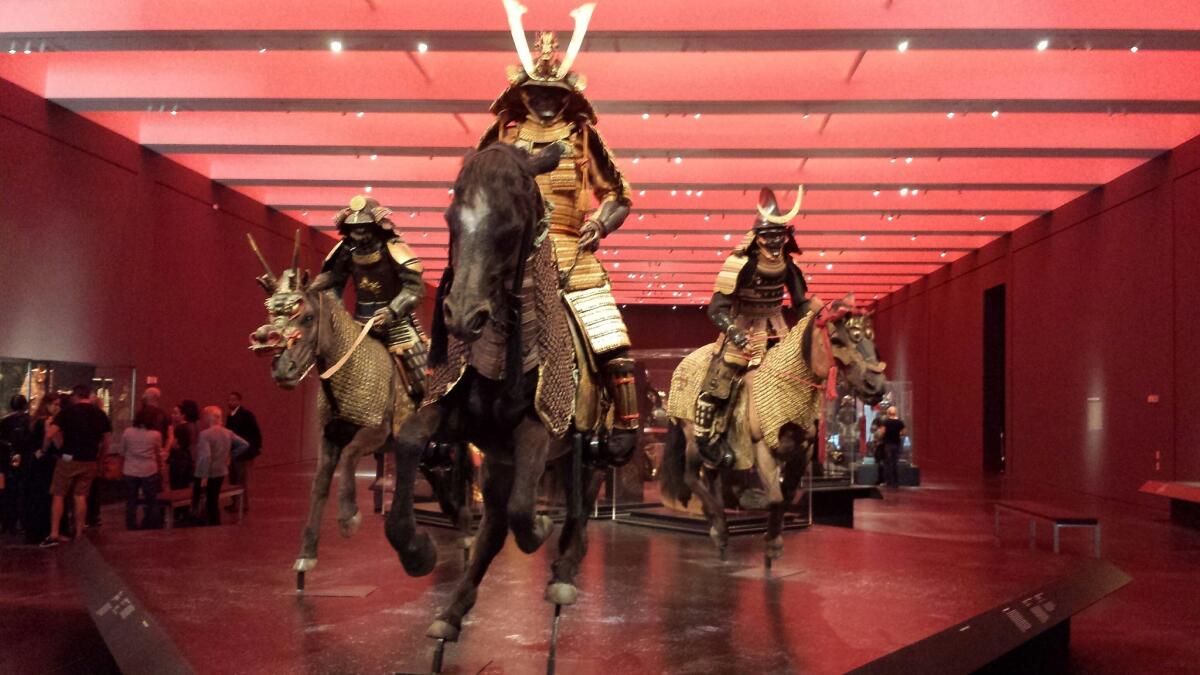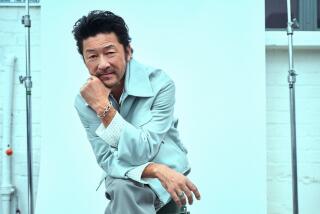Stunning samurai armor, bathed in red, on exhibit at LACMA

“Throne of Blood,” Akira Kurosawa’s eloquently stylized 1957 reimagining of Shakespeare’s “Macbeth” as a 16th century Japanese samurai saga, hovers in the flushed, rosy atmosphere of a new exhibition at the Los Angeles County Museum of Art.
Kurosawa’s movie was filmed in radiant black-and-white. Yet, the highly unusual use of crimson lighting overhead for “Samurai: Japanese Armor from the Ann and Gabriel Barbier-Mueller Collection” has the tragedy’s bloody fingerprints all over it. Darth Vader’s famous “Star Wars” costume isn’t the only samurai reference in classic film.
The touring show comes from a private Dallas museum. In more than 140 objects of warrior regalia, it surveys often stunningly designed samurai suits of armor, face masks, swords, shin guards and breast plates, horse garments (including remarkable lacquered stirrups), helmets – even metal fans.
Among the most beautiful elements are the elaborate lacings, which allow for a soldier’s mobility when wearing a clanking carapace. The lacings’ visual delicacy belies their physical strength – a kind of concentrated version of a samurai warrior.
Kulapat Yantrasast of Culver City’s wHY Architecture designed the installation. He covered the saw-tooth skylights overhead in the Resnick Pavilion to block the sun, tucking red filters into the recesses of the lighting system. Typically this sort of startling theatricality intrudes on a show – but not here, where it instead enhances the theme of armorial spectacle.
In Japan, red is the color of the sun, as witness the red disk in the center of the national flag. The rosy light reflects off the white ceiling and is diffused overhead, gently bathing the exhibition. The glow speaks simultaneously of elegant sexiness and “Throne of Blood” violence.
Samurai were essentially private feudal militias – the Blackwater private security contractors of their day. Compared to the frantic battle scene with which the show opens – three samurai mounted on horseback at full if frozen gallop – the stately, formal, almost symmetrical procession through the exhibition evokes ritual pageantry.
Most of the objects date from the late-18th and 19th centuries. As feudal Japan passed through an extended era of peace and prosperity during the Edo period (1603-1868), the necessity for battle-worthy armor steadily declined. It was usurped by a peacock’s desire for thrilling display.
Samurai, relatively short in stature, puffed up their physical size with visual razzle-dazzle. Their armor is replete with inlaid designs and sculptural adornments, both whimsical (ocean waves, vegetables) and fierce (snakes, birds of prey, dragons). War lords paraded between the seat of power in what is modern Tokyo and their provincial homes around the country. In the gallery, the military parade becomes a veritable fashion show.
Yantrasast, who is Thai, is no stranger to Japanese aesthetics: He worked for seven years with Pritzker Prize architect Tadao Ando, and he started wHY Architects with Yo-ichiro Hakomori, a former fellow student at the University of Tokyo.
With the compelling and illuminating scheme for “Samurai,” he now joins architects Frank O. Gehry and Frederick Fisher as a provocative exhibition designer on the recent LACMA roster.
Twitter: @KnightLAT
More to Read
The biggest entertainment stories
Get our big stories about Hollywood, film, television, music, arts, culture and more right in your inbox as soon as they publish.
You may occasionally receive promotional content from the Los Angeles Times.











